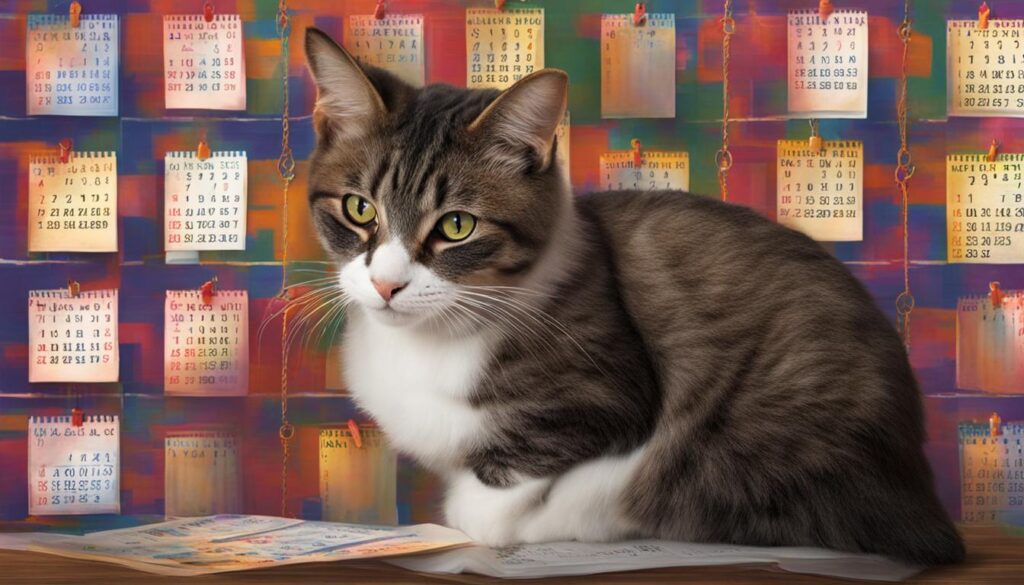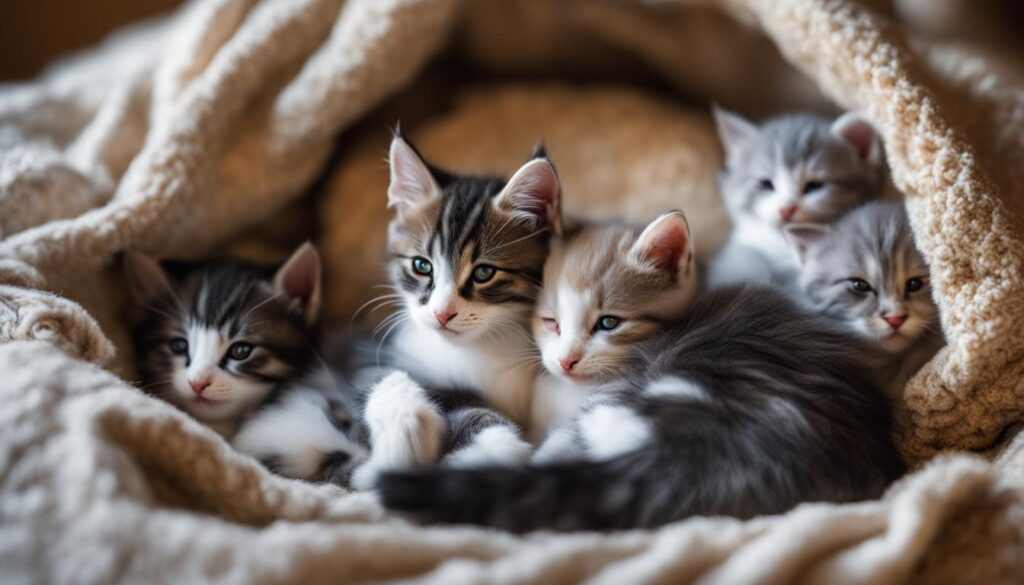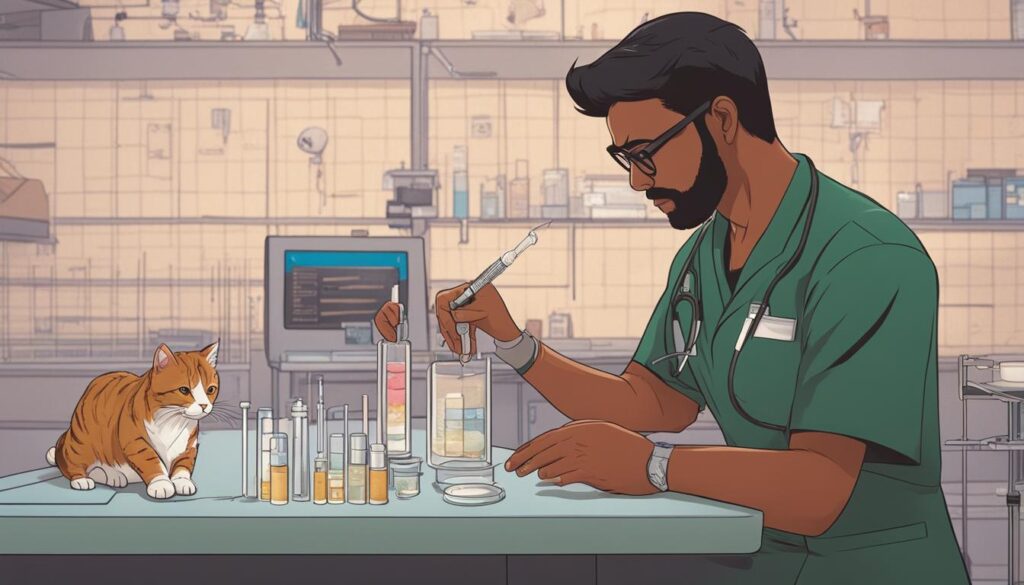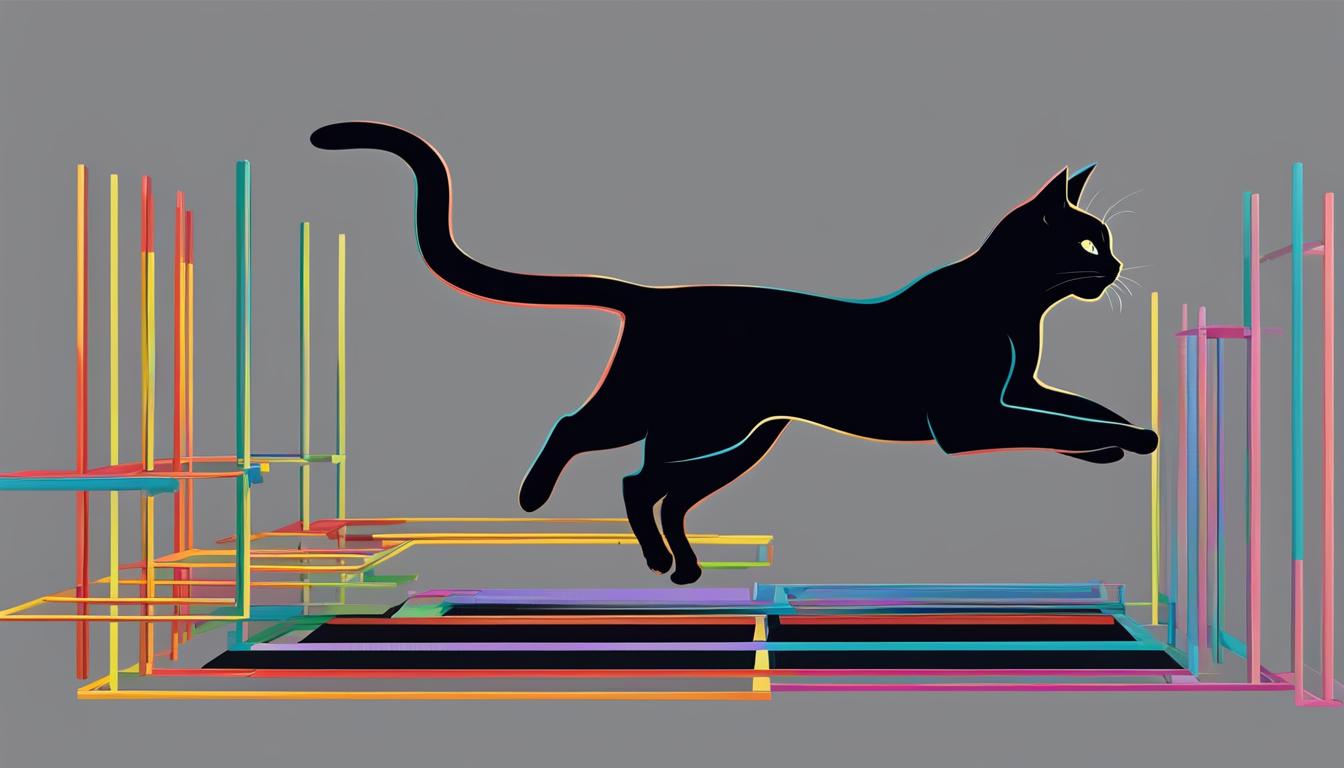As a cat lover, I’ve always been fascinated by the mysteries of feline reproduction. How do these graceful creatures bring new life into the world? What factors contribute to successful breeding? In my quest for answers, I’ve delved into the intriguing world of feline reproduction science. Join me on this journey as we explore the behavioral, gonadal, and endocrine aspects that shape the feline reproductive process.
Key Takeaways:
- Cats are seasonally polyestrous and long-day breeders, with estrous cycles occurring at variable intervals of 14 to 21 days.
- The onset of estrous activity is influenced by the length of daylight, with peak activity typically seen in the northern hemisphere from February to April.
- Longhair breeds are more sensitive to daylight length than shorthair breeds, and inadequate light exposure can lead to infrequent estrous cycles.
- The first estrus typically occurs in queens between 5 and 9 months of age, influenced by factors such as breed, season, and body condition.
- The feline estrous cycle consists of proestrus, estrus, interestrus, anestrus, and luteal phases, with the average length of estrus being 5.8 ± 3.3 days.
Understanding the Feline Estrus Cycle
The feline estrous cycle is a complex process that can be divided into several phases, each with its own characteristics. It is important for cat breeders and owners to understand these phases to effectively manage feline reproduction. Let’s take a closer look at each stage of the feline estrus cycle.
Proestrus
In the proestrus phase, queens may display affectionate behavior and have a slight mucoid vulvar discharge. This phase is characterized by preparatory behaviors and typically lasts for a few days. It signals the beginning of the reproductive cycle.
Estrus
Estrus is the phase in which queens are behaviorally receptive to mating. During this time, they assume a characteristic body posture called lordosis, indicating their readiness to mate. Estrus can last from 2 to 19 days, with an average duration of 5.8 ± 3.3 days. This is the most crucial phase for successful breeding.
Interestrus and Anestrus
Interestrus refers to the period between estrus cycles, where queens exhibit low levels of estrogen and no sexual behaviors. Anestrus, on the other hand, refers to the absence of cycling activity. It naturally occurs during periods of short daylight. These phases provide a resting period for the queen’s reproductive system.
Luteal Phase
The luteal phase is the period after ovulation when progesterone becomes the dominant hormone. It prepares the uterus for potential pregnancy. The feline placenta is endotheliochorial in structure and zonary in shape. Pregnancy length can vary from 62 to 74 days, with an average length of 65 to 67 days.
By understanding the feline estrus cycle, breeders and cat owners can determine the optimal timing for mating and ensure the overall reproductive health of their feline companions.

>Puberty and Seasonality in Queens>
Understanding the onset of puberty and the influence of seasonality is crucial for cat breeders and owners. Puberty in queens typically occurs between 5 and 9 months of age, but it can vary depending on factors such as breed, season, and overall body condition. For example, shorthair breeds like Siamese and Burmese tend to reach puberty at a lower body weight compared to longhair breeds.
Seasonality also plays a significant role in the reproductive cycle of queens. Cats are considered long-day breeders, meaning the length of daylight affects their estrous cycles. Increasing daylight length in the months of January and February promotes estrous activity. However, cats housed indoors may experience winter anestrus due to the shorter length of daylight.
To ensure regular estrous cycles, breeders should provide adequate light exposure to their cats. This can be achieved through natural daylight or artificial light, with a recommended duration of 12 to 14 hours per day. Longhair breeds are more sensitive to the amount of daylight than shorthair breeds, so it’s essential to monitor their light exposure closely.
By understanding the timing of puberty and the effects of seasonality, cat breeders and owners can optimize their breeding programs and ensure the overall reproductive health of their queens.
Cat Mating and Pregnancy Care
The process of cat mating can be quite vocal and frequent. Male cats have barbed penises that stimulate the female cat to ovulate, increasing the chances of pregnancy. Female cats can become pregnant during their first heat, which can occur as early as 4 months of age. Signs of a female cat in heat include increased vocalization, restlessness, and affectionate behavior. It’s important to understand these behaviors to prevent unwanted pregnancies and ensure responsible breeding practices.
During the mating process, male cats may exhibit strong behaviors in their pursuit of a female in heat. They may attempt to tear down screens or make attempts to escape to find a potential mate. If a female cat has had access to a male cat during her heat, the likelihood of pregnancy is high. Awareness of mating behaviors can help breeders and cat owners take necessary precautions to control and manage the breeding process.
Once a cat is pregnant, it’s essential to provide proper care to both the mother cat and the developing kittens. Around three weeks after mating, physical and personality changes become more evident in the pregnant cat. It is recommended to consult with a veterinarian to ensure the well-being of the pregnant cat and receive guidance on providing the necessary care. This includes providing a nutritious diet, increasing the quantity of food, and creating a quiet and private nesting area for the pregnant cat.

Table: Common Mating Behaviors in Cats
| Behavior | Description |
|---|---|
| Vocalization | Increased vocalizations during the heat cycle to attract potential mates. |
| Restlessness | Increased activity and restlessness, often seen in the search for a mate. |
| Affectionate Behavior | Increased desire for affection and attention from humans. |
| Mating Posture | Assuming a lordosis posture, with the body positioned low to the ground and the tail turned to one side. |
| Escape Attempts | Male cats may exhibit heightened efforts to escape or find a female in heat. |
Cat mating and pregnancy care require a responsible approach to ensure the health and well-being of all involved. By understanding the mating behaviors of cats and providing appropriate care during pregnancy, breeders and cat owners can contribute to the responsible and ethical breeding practices that enhance feline welfare.
Feline Birth and Kitten Care
Welcoming a litter of adorable kittens into the world is an exciting and rewarding experience for any cat owner. Proper care during feline birth and the early stages of kitten development is essential for ensuring their health and well-being. Here are some important considerations and tips to help you navigate this special time.
Preparing for Feline Birth
As the gestation period comes to an end, it’s crucial to create a comfortable and safe environment for the pregnant queen. Set up a nesting box in a warm, quiet area where she can give birth and nurse her kittens. Line the box with soft bedding and ensure it is large enough to accommodate the mother cat and her growing litter. Place the nesting box in a secluded spot, away from noise and disturbances, to provide the queen with privacy and reduce stress.
Provide the mother cat with a nutritious diet during pregnancy to support her health and the development of the kittens. Consult with your veterinarian to determine the best diet and feeding schedule for the gestation period. Make sure to provide fresh water at all times, and monitor the queen closely for any signs of discomfort or complications.
Assisting with Feline Birth
Most queens are capable of giving birth and caring for their kittens without human intervention. However, it’s essential to be prepared and know when to seek assistance if needed. Monitor the queen closely as her due date approaches, watching for signs of labor, such as restlessness, nesting behavior, and contractions. If the mother cat experiences prolonged labor (over 30 minutes) without producing a kitten or shows signs of distress, contact your veterinarian immediately.
Once the kittens are born, take note of their appearance and ensure each one is breathing, moving, and nursing. The mother cat will typically clean the kittens and sever their umbilical cords; however, you may need to step in and assist if necessary. Use a clean towel to gently dry the kittens and tie off the umbilical cords with sterile thread approximately one inch from the kitten’s body. Be careful not to pull or cut the cord too closely, as this may cause bleeding or infection.
Remember to provide a quiet and stress-free environment for the queen and her newborns as they bond and establish nursing routines. Minimize handling the kittens during the first week to allow the mother cat to establish maternal behavior and ensure the kittens receive proper nourishment.

Managing Feline Infertility and Genetic Testing
When it comes to cat breeding, managing feline infertility is a significant concern for breeders. Several factors can contribute to feline infertility, including nutritional deficiencies, environmental stressors, infectious diseases, and toxic exposures. Identifying and addressing these factors is crucial for improving breeding success rates and producing healthy offspring.
One effective tool in the realm of responsible cat breeding is genetic testing. Genetic testing allows breeders to identify potential genetic diseases and prevent their transmission to future generations. By testing breeding cats for specific genetic markers, breeders can make informed decisions and choose mating pairs that minimize the risk of producing offspring with inherited disorders.
| Factors contributing to feline infertility: | Genetic testing benefits: |
|---|---|
| Nutritional deficiencies | Identification of potential genetic diseases |
| Environmental stressors | Prevention of inherited disorders |
| Infectious diseases | Improved breeding success rates |
| Toxic exposures | Healthier offspring |
Genetic testing can help breeders understand the genetic makeup of their breeding cats, allowing them to make informed decisions about pairings. This not only improves the overall health and well-being of the offspring but also helps preserve and enhance desirable traits within specific breeds.
By managing feline infertility and utilizing genetic testing, breeders can take proactive steps to improve the overall health and quality of their feline lineages. With a focus on responsible breeding practices, breeders can contribute to the betterment of feline welfare and ensure that future generations of cats are healthy and thriving.

Conclusion
Wow, feline reproduction science is truly fascinating! Over the years, we have made significant progress in understanding the complexities of the feline estrus cycle, puberty, and seasonality. This knowledge is crucial for responsible cat breeding, ensuring that we give our furry friends the best care possible.
Providing proper care for pregnant cats is essential for the health and well-being of both the mother cat and her kittens. From a nutritious diet to a quiet nesting area, every little detail counts. And let’s not forget about managing feline infertility. There are various factors that can affect a cat’s reproductive abilities, but proper nutrition and environmental conditions play a significant role.
Genetic testing is a game-changer in the world of ethical cat breeding. By identifying potential genetic diseases, breeders can make informed decisions and breed healthier cats. It’s all about ensuring the well-being of our feline friends and contributing to their overall welfare.
So, fellow breeders and cat owners, let’s stay informed about the science of feline reproduction. Together, we can make a difference and create a better future for cats everywhere. After all, they deserve nothing but the best!
FAQ
What is the average length of the feline estrus cycle?
The average length of the feline estrus cycle is 5.8 ± 3.3 days.
At what age does a queen typically experience her first estrus?
Queens typically experience their first estrus between 5 and 9 months of age.
How long does a cat’s pregnancy typically last?
The average length of gestation for cats is 65 to 67 days.
What are the signs of a female cat in heat?
Signs of a female cat in heat include increased vocalization, restlessness, and affectionate behavior.
Do cats require assistance during the birth process?
Most queens do not require assistance during the birth process, but it is important to monitor for potential problems and take appropriate action if necessary.
What can cause feline infertility?
Feline infertility can be caused by various factors, including nutritional deficiencies, environmental stressors, infectious diseases, and toxic exposures.
How can genetic testing help with responsible cat breeding?
Genetic testing can help identify potential genetic diseases and prevent their transmission, allowing breeders to make informed decisions and reduce the risk of producing offspring with inherited disorders.





